Introduction to Emotional Regulation through ABA Therapy
Applied Behavior Analysis (ABA) therapy is a well-established approach that assists individuals, particularly those with autism spectrum disorder (ASD), in developing vital emotional regulation skills. Effective emotional regulation is essential in managing overwhelming feelings, reducing the likelihood of behavioral challenges, and fostering well-being and social interactions. In this article, we delve into how ABA therapy facilitates this process, exploring the techniques and strategies employed to enhance emotional regulation, and answer common questions around this important therapeutic method.
Understanding Emotional Regulation and Its Importance in Autism
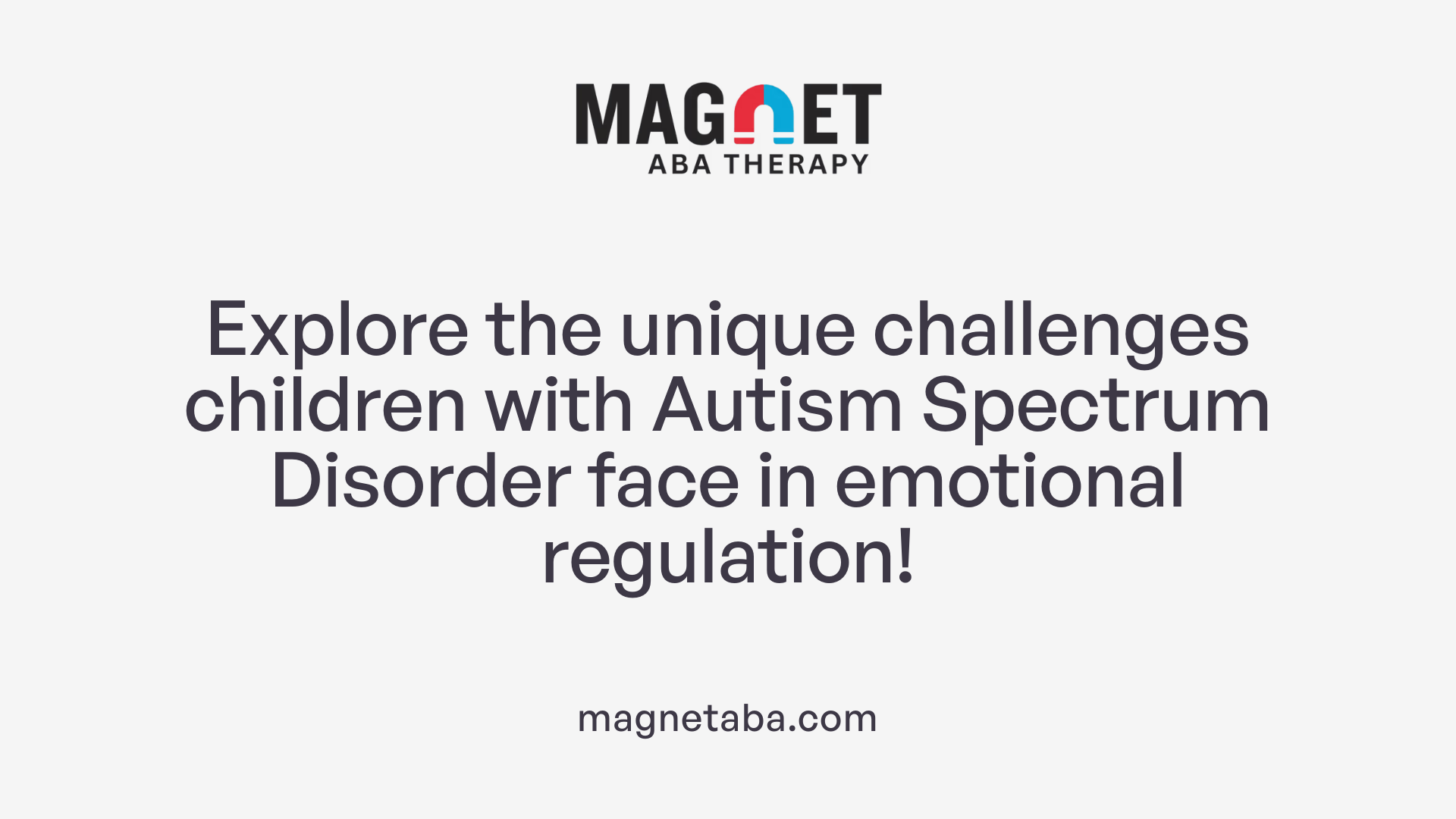
Characteristics of ASD Affecting Emotional Regulation
Children with Autism Spectrum Disorder (ASD) often face unique challenges in emotional regulation due to characteristics such as alexithymia, which hinders their ability to recognize and articulate emotions. Language impairments can further complicate their expression and understanding of feelings, and deficits in perspective-taking may result in difficulty relating to others' emotions.
Common Emotional and Behavioral Challenges in Autism
Disrupted emotional regulation in children with ASD can lead to serious behavioral disturbances. Instead of being viewed simply as acts of defiance, behaviors like tantrums and aggression are often the result of emotional mismanagement. Impulsivity and ineffective inhibition can prevent these children from applying coping strategies they have learned, leading to explosive reactions during moments of distress.
Importance of Emotional Regulation Skills
Developing emotional regulation skills is crucial as it allows individuals with autism to manage overwhelming feelings effectively. This skill set is vital to reduce outbursts and improve social interactions. Through approaches like Applied Behavior Analysis (ABA), children can learn to identify emotions through tools like the three-point scale, which categorizes feelings into zones.
How to Teach Emotional Regulation?
To teach emotional regulation, caregivers must foster an environment where children can identify and discuss their feelings via activities such as feelings charts. Important techniques include:
- Modeling Positive Emotional Responses: Engaging in conversations about emotions during calm moments reinforces understanding.
- Mindfulness Practices: Deep breathing and yoga can help children manage emotions effectively.
- Scaffolding Learning: Guide children step-by-step through challenges until they can manage independently.
- Collaboration: Working closely with educators enhances the application of these strategies in various settings.
By implementing these techniques, children can gain better emotional awareness, enhancing their problem-solving abilities and overall well-being.
Principles and Practices of ABA Therapy in Emotional Regulation
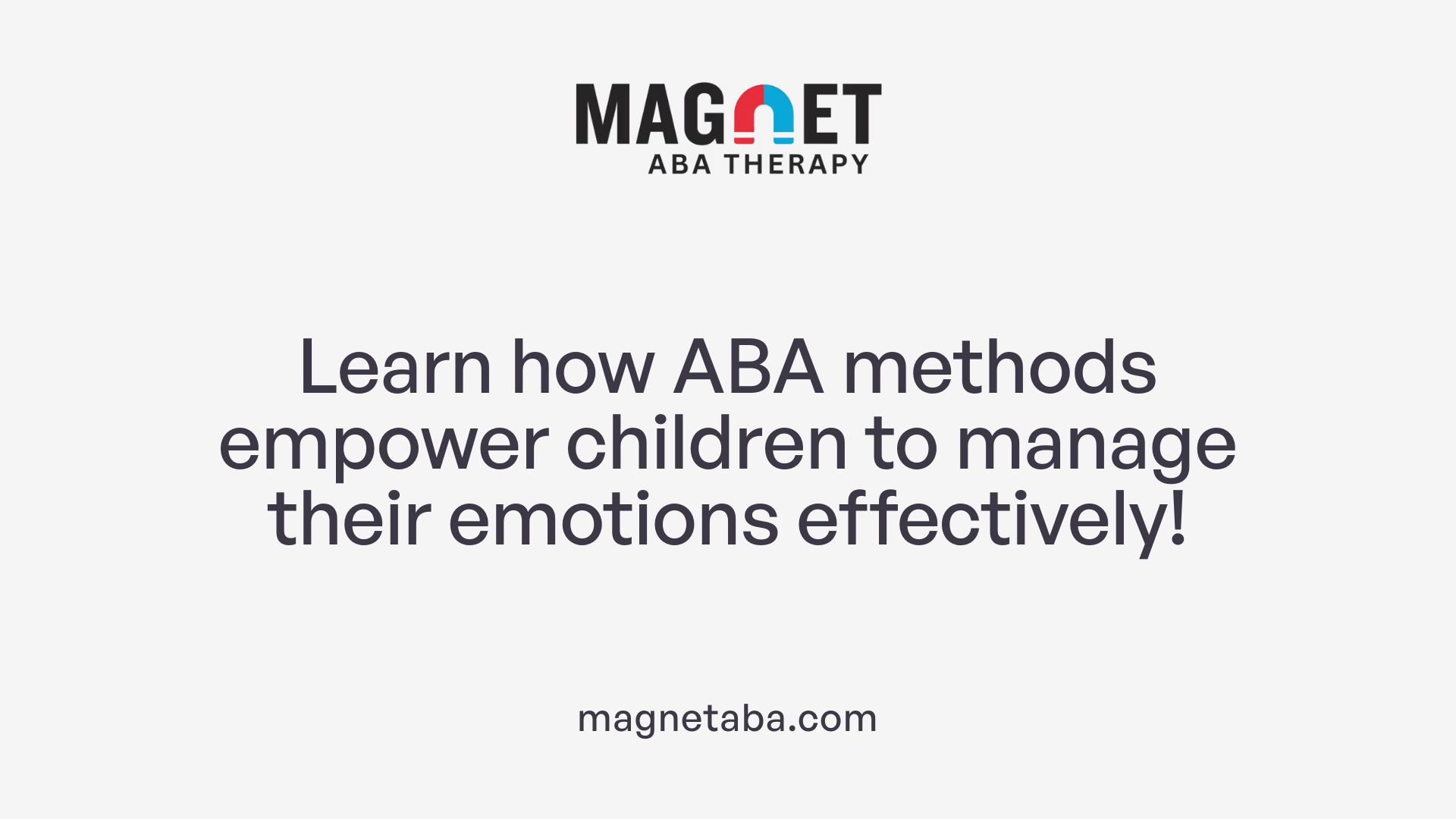
Role of ABA in Teaching Emotional Regulation
Applied Behavior Analysis (ABA) plays a significant role in helping individuals, particularly children with autism, develop emotional regulation skills. One of the fundamental aspects of ABA is its focus on observable and measurable behaviors, which enables practitioners to pinpoint specific emotional triggers and responses in children. Through established interventions, ABA teaches individuals to recognize their emotions and effectively manage them before they escalate into more significant behavioral issues, fostering a proactive approach to emotional challenges.
Observable and Measurable Behaviors in ABA
The strengths of ABA lie in its systematic application of strategies to teach emotional regulation. Techniques such as visual tools like stoplight colors help children identify their emotional states clearly. This visual representation aids in articulating feelings, crucial for those who struggle to express themselves verbally. Additionally, behaviors are modeled during therapy sessions, where therapists not only label emotions but also demonstrate appropriate responses, allowing children to learn the correct emotional expressions in various contexts.
Benefits of ABA for Emotional Management
The benefits of ABA for emotional management extend beyond just coping strategies. ABA emphasizes role-playing calming techniques, giving children safe environments to practice responses to emotional distress. When these skills are taught during calm moments and reinforced through regular feedback, children can generalize their emotional regulation techniques to real-life scenarios. Furthermore, consistent application of these methods across home and school settings ensures children are supported in their journey to independent emotional management, which ultimately enhances their overall well-being.
| Topic | Description | Importance |
|---|---|---|
| Emotional Self-Identification | Learning to recognize one's feelings | Reduces risk of outbursts |
| Role-Playing | Practicing calming techniques in safety | Builds confidence in emotional responses |
| Visual Tools | Using stoplight colors for emotions | Facilitates understanding and expression |
Evidence-based Strategies for Emotional Regulation in ABA
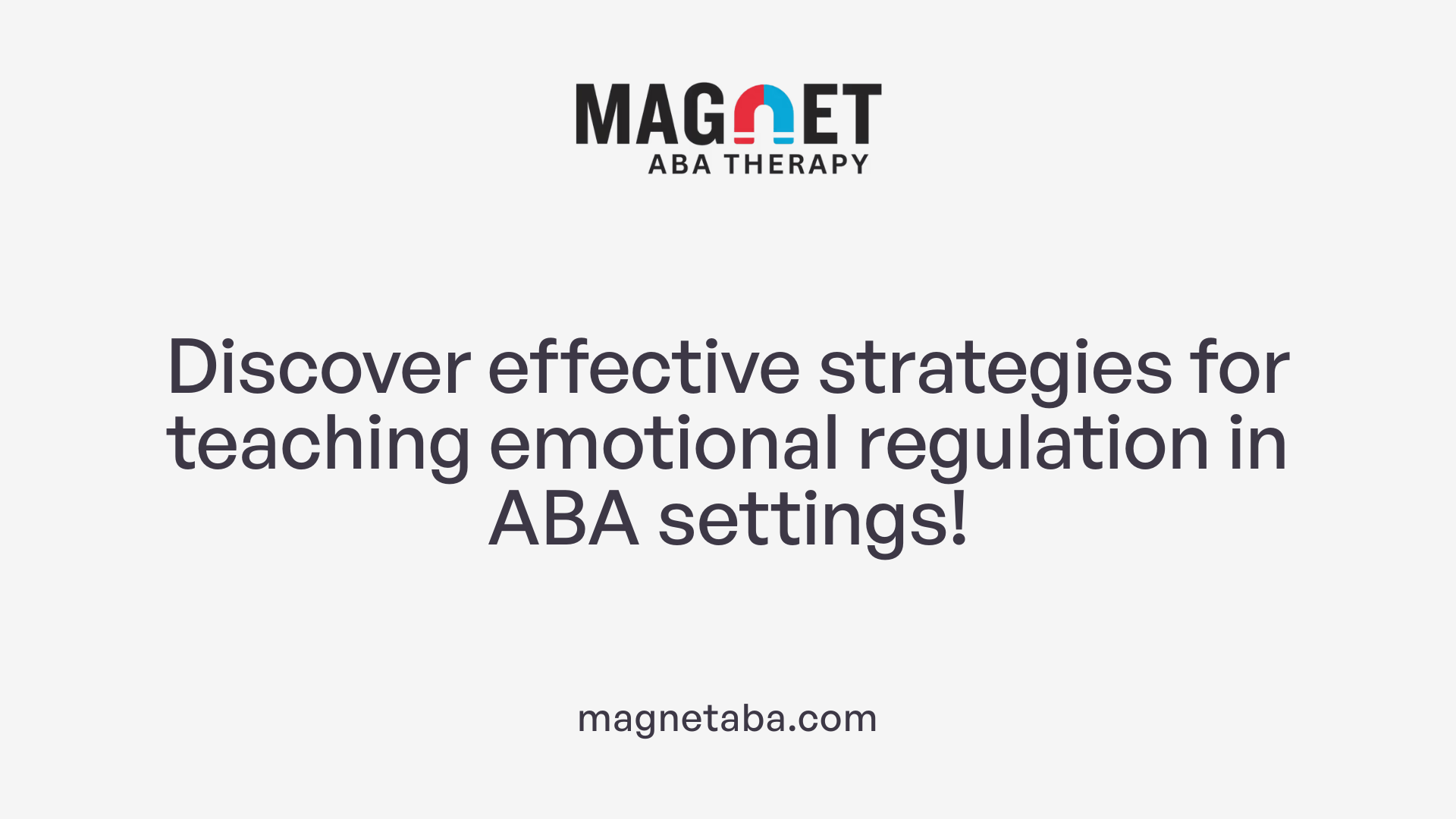
Role-playing and feedback in emotional management
Role-playing is a crucial strategy within Applied Behavior Analysis (ABA) when teaching emotional regulation. By simulating various scenarios, students can practice and refine their emotional responses in a controlled environment. This technique allows children to safely explore their feelings, learn from mistakes, and receive constructive feedback from educators or therapists.
Providing feedback reinforces the strategies learned during role-play, ensuring students understand how to manage their emotions. This collaborative effort creates a supportive atmosphere where children can express themselves without fear of judgment.
Teaching emotions through visuals
Visual aids are particularly effective when teaching children emotional regulation. Tools like the stoplight or three-point scale help represent various emotional states: green for calm, yellow for frustrated, and red for anger. Visuals simplify complex feelings, making it easier for children to identify their emotional status.
Using these visuals during calm moments enables children to articulate their emotions proactively, rather than in distressful situations. This foundational knowledge helps reduce impulsive reactions when emotions escalate.
Generalization of emotional strategies
One of the most vital components in emotional regulation is the ability to apply learned strategies across diverse environments. Generalization prepares children to use their coping mechanisms in different situations outside of therapy or school. Instructors should introduce these strategies in various settings and contexts to help students build confidence.
By combining structured teaching methods with real-life applications, children can internalize emotional regulation techniques. This approach assists in disrupting negative behavior patterns, ultimately leading to healthier emotional experiences.
| Strategy | Description | Impact on Emotional Regulation |
|---|---|---|
| Role-playing | Simulates scenarios for practice | Enhances emotional response awareness |
| Visual aids | Uses scales to represent emotions | Simplifies emotion identification |
| Strategy generalization | Applies techniques in various contexts | Builds confidence and reduces negative behaviors |
These evidence-based strategies from ABA provide a solid foundation for improving emotional regulation in children, particularly those with autistic spectrum disorders.
Implementing Emotional Regulation Skills in Daily Life
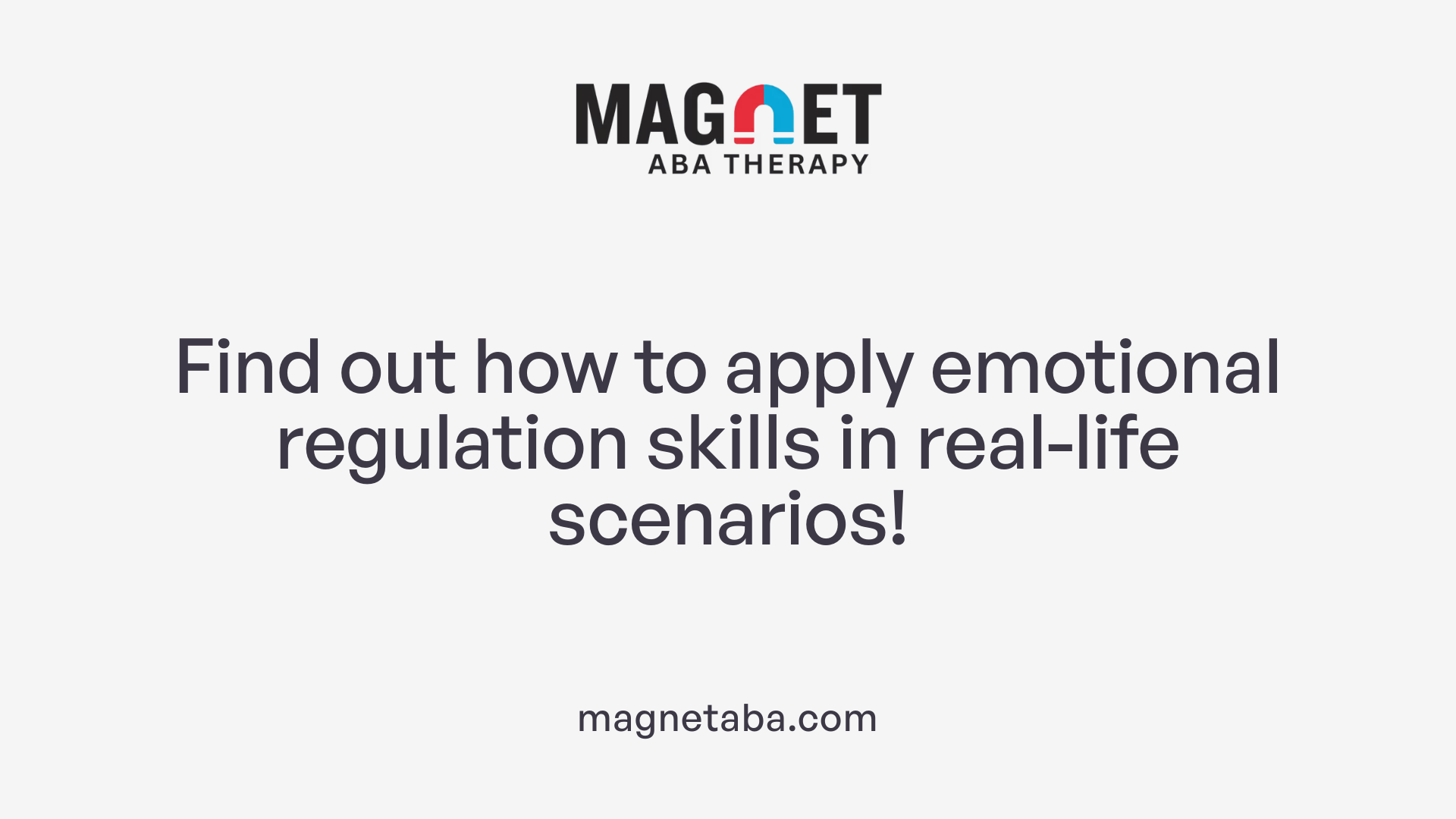
How can ABA techniques be generalized?
Generalizing techniques learned through Applied Behavior Analysis (ABA) is essential for students to implement emotional regulation skills across different environments. Practicing these methods in various settings helps children recognize and manage their emotions more effectively when they encounter real-life situations.
Why involve parents and educators in ABA?
Collaboration among therapists, parents, and educators is critical for reinforcing emotional regulation skills. Regular communication ensures that techniques taught during therapy are consistently applied at home and in school, solidifying the child's emotional management strategies.
What are practical applications of learned strategies?
To facilitate practical application, educators can utilize tools like the three-point scale, where children categorize their feelings using colors. Teaching calming techniques—like deep breathing or taking walks—combined with consistent feedback enhances children's ability to cope independently. Role-playing scenarios further prepare children for emotional challenges, building their resilience and ability to express feelings in an appropriate manner.
Addressing Emotional Dysregulation in Children with ASD
Impact of emotional dysregulation
Children with Autism Spectrum Disorder (ASD) often face significant challenges with emotional regulation, leading to inappropriate emotional outbursts such as tantrums or aggression. These reactions may stem from a lack of coping strategies and can be exacerbated by characteristics of ASD like alexithymia or impulsivity. Without proper support, disruptions in emotional regulation can hinder their social interactions and overall development.
Common mistakes in handling emotional outbursts
Parents and educators sometimes misinterpret emotional outbursts as deliberate defiance. This misconception undermines the underlying emotional distress and may result in punitive responses that fail to teach effective coping mechanisms. Rather than simply telling children to calm down, it’s crucial to validate their feelings and guide them in recognizing their emotions in a supportive way.
Strategies to prevent emotional escalations
Preventing emotional escalations involves several proactive strategies:
- Modeling Behaviors: Regularly labeling emotions helps children recognize and articulate their feelings.
- Visual Tools: Tools like the three-point scale categorize emotional states and help children express how they feel.
- Calming Techniques: Teaching strategies such as deep breathing or going for a walk allows children to self-soothe independently.
- Regular Feedback: Providing constructive feedback reinforces the use of learned coping strategies in different environments.
Through consistent and collaborative efforts among parents, therapists, and educators, children with ASD can develop essential emotional regulation skills, leading to improved well-being.
Teaching Coping Strategies for Effective Emotional Management
Role-playing calming techniques
Role-playing is a dynamic method to equip children with coping strategies to manage emotional distress. This practice allows students to act out calming techniques in a safe environment, enabling them to rehearse how to respond appropriately when faced with overwhelming feelings. For example, role-playing scenarios can illustrate how to take deep breaths, count to ten, or even excuse themselves to a designated quiet area.
By engaging in these simulations, children are given the tools to recognize triggers and practice their responses. They learn valuable skills to defuse stress in real-life situations and build resilience.
Use of the three-point scale for identifying emotions
The three-point scale is an effective visual tool for helping children articulate their emotional states. This method categorizes feelings into three distinct zones:
| Zone | Emotion | Description |
|---|---|---|
| Green | Calm | The child feels composed and is in a good state of mind. |
| Yellow | Frustrated/Anxious | The child might be experiencing mild distress. |
| Red | Angry/Very Anxious | The child's emotions are heightened and may lead to outbursts. |
Using this framework during calmer moments enables children to identify their feelings rather than suppress them. Educators can reinforce this method by validating emotions and encouraging discussions around them.
Practicing calming routines
Implementing calming routines is critical in teaching children how to regulate their emotions effectively. These routines can involve various strategies such as deep breathing exercises, mindfulness activities, or physical movement like taking a short walk. By establishing a routine that includes these calming techniques, children learn to soothe themselves independently.
To foster self-regulation, it's important to notice early signs of emotional escalation and to practice these techniques during calm moments. This proactive approach makes it easier for students to apply what they've learned when faced with stress, ultimately enhancing their emotional resilience.
What are self-regulation ABA goals?
Self-regulation ABA goals center around helping students, especially those with disabilities, to understand and manage their emotions and behaviors effectively. These objectives often include enhancing emotional regulation through various coping strategies and impulse-control skills.
For example, students may be encouraged to ask for sensory breaks or identify their emotions during stressful situations. Moreover, these goals should adhere to the SMART framework, ensuring they are specific, measurable, achievable, relevant, and time-bound, ultimately promoting independence and meaningful growth in self-regulation skills.
Collaborative Efforts in ABA for Enhanced Emotional Regulation
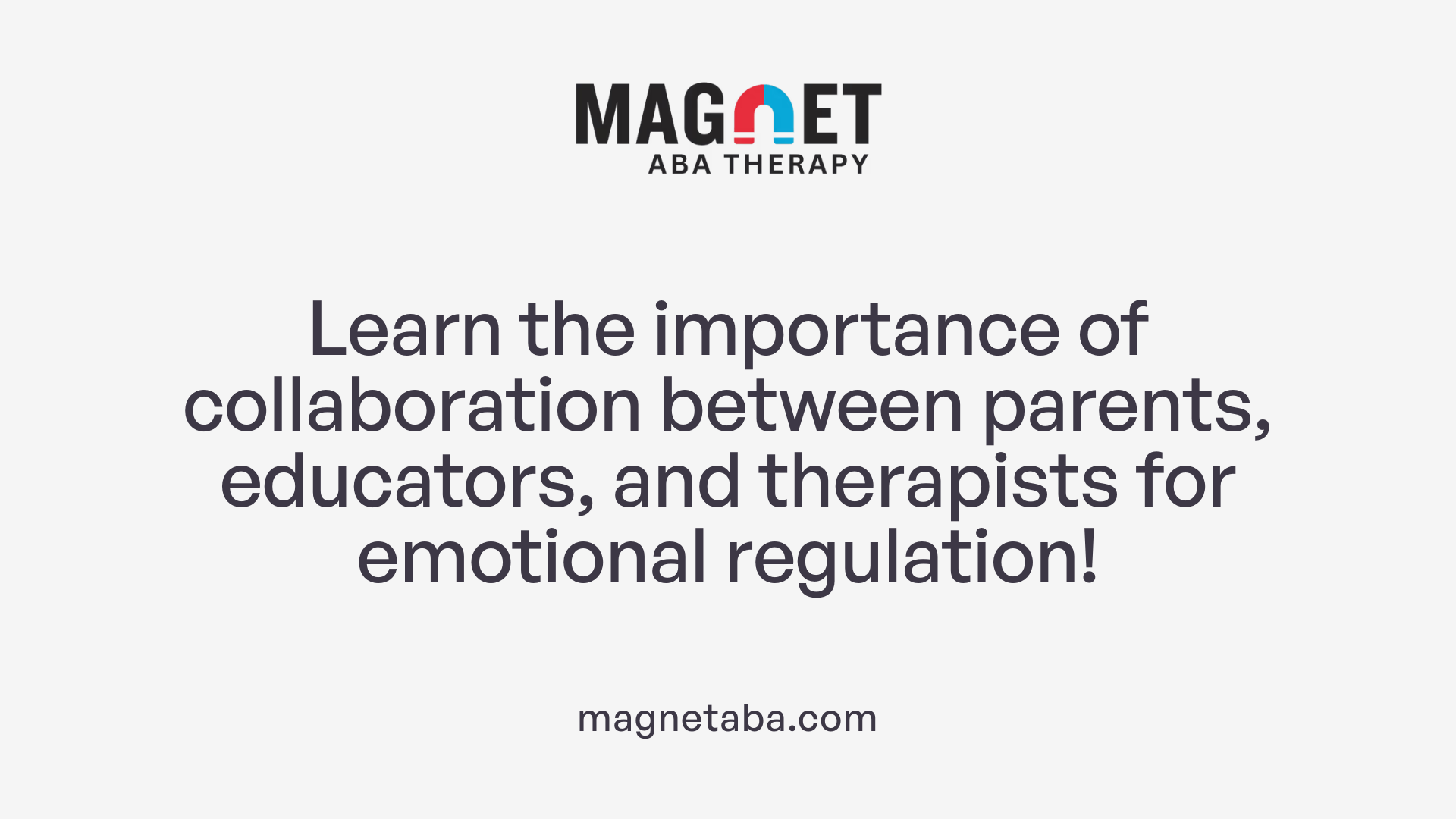
Importance of Consistency
To effectively teach emotional regulation strategies to children with autism, consistency is key. Techniques learned during therapy must be applied consistently at home, school, and in social environments. This reinforcement helps solidify coping strategies, making them readily accessible when emotional challenges arise.
Role of Parents and Educators
Parents and educators play a vital role in this collaborative approach. They should actively engage in the learning process by practicing strategies alongside the child. When parents reinforce the techniques during daily activities, it promotes generalization, allowing the child to apply these skills effectively in various contexts.
Application of ABA Techniques in Various Settings
ABA techniques, such as role-playing and visual aids, should be adapted for use in different environments. For instance, using the three-point scale at home and in the classroom can help children articulate their emotions consistently, bridging the gap between therapy and real-life situations.
By fostering a cooperative network among therapists, parents, and educators, children with autism can achieve better emotional regulation, improving their quality of life.
Integration of ABA Therapy with Other Therapeutic Approaches
Complementary therapies for emotional regulation
Integrating various therapeutic approaches can enhance emotional regulation for children with autism. While Applied Behavior Analysis (ABA) focuses on observable actions, incorporating therapies like Cognitive Behavioral Therapy (CBT) can offer a more rounded approach. CBT's emphasis on managing thoughts and feelings complements ABA's skill-building nature.
Therapies like CBT and their integration with ABA
CBT is effective for emotional regulation as it teaches coping strategies alongside identifying and challenging negative thoughts. When paired with ABA techniques, it provides children with a dual framework: understanding emotional triggers from a cognitive perspective and reinforcing appropriate behaviors through structured methodologies of ABA.
Building a holistic approach to emotional management
A holistic approach involves not only emotional regulation strategies but also social skills training. Consistency across settings—home, school, and therapy—ensures the effectiveness of the strategies learned. Working collaboratively, therapists, educators, and parents can create an environment where children feel secure and supported in applying their skills. This partnership is vital for fostering resilience and improving relational dynamics in everyday situations.
Conclusion: Empowering Lives through ABA
ABA therapy plays a crucial role in helping individuals, especially those with autism, to manage their emotions and navigate social interactions more effectively. By employing structured techniques and strategies aimed at emotional regulation, ABA empowers individuals to lead more balanced and fulfilling lives. This therapy is most effective when combined with collaborative efforts and supplementary therapeutic approaches, ensuring a comprehensive framework for emotional development. With ongoing application and reinforcement, the skills learned through ABA create lasting impacts on emotional well-being and overall quality of life.
References
- How to Teach Emotional Regulation - How to ABA
- Emotion Regulation: Concepts & Practice in Autism Spectrum Disorder
- Emotional Regulation in Autism - How to ABA
- ABA Therapy's Role in Emotional Regulation
- Dealing with Feelings: How I Help My Clients with Emotion Regulation
- Emotional Regulation: 5 Evidence-Based Regulation Techniques
- Simple evidence-based strategies for teaching emotion regulation?












